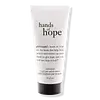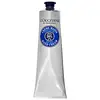What's inside
What's inside
 Key Ingredients
Key Ingredients

 Benefits
Benefits

 Concerns
Concerns

 Ingredients Side-by-side
Ingredients Side-by-side

Water
Skin ConditioningGlycerin
HumectantShea Butter Glycerides
EmulsifyingCetearyl Alcohol
EmollientGlyceryl Stearate
EmollientDimethicone
EmollientPolyacrylamide
Stearic Acid
CleansingSd Alcohol 40-B
AstringentBenzyl Alcohol
PerfumingHydrolyzed Hyaluronic Acid
HumectantBeta-Glucan
Skin ConditioningArginine
MaskingPanthenyl Ethyl Ether
Prunus Amygdalus Dulcis Oil
Skin ConditioningHelianthus Annuus Seed Oil
EmollientLimnanthes Alba Seed Oil
Skin ConditioningLinum Usitatissimum Seed Oil
PerfumingOryza Sativa Bran Oil
EmollientPolyamide-5
Skin ConditioningC13-14 Isoparaffin
EmollientLaureth-7
EmulsifyingMethyl Gluceth-20
HumectantAmmonium Acryloyldimethyltaurate/Vp Copolymer
Ethyl Macadamiate
Skin ConditioningSclerotium Gum
Emulsion StabilisingEthylhexylglycerin
Skin ConditioningTocopheryl Acetate
AntioxidantSodium Hydroxide
BufferingXanthan Gum
EmulsifyingDisodium EDTA
Citric Acid
BufferingPhenoxyethanol
PreservativeChlorphenesin
AntimicrobialWater, Glycerin, Shea Butter Glycerides, Cetearyl Alcohol, Glyceryl Stearate, Dimethicone, Polyacrylamide, Stearic Acid, Sd Alcohol 40-B, Benzyl Alcohol, Hydrolyzed Hyaluronic Acid, Beta-Glucan, Arginine, Panthenyl Ethyl Ether, Prunus Amygdalus Dulcis Oil, Helianthus Annuus Seed Oil, Limnanthes Alba Seed Oil, Linum Usitatissimum Seed Oil, Oryza Sativa Bran Oil, Polyamide-5, C13-14 Isoparaffin, Laureth-7, Methyl Gluceth-20, Ammonium Acryloyldimethyltaurate/Vp Copolymer, Ethyl Macadamiate, Sclerotium Gum, Ethylhexylglycerin, Tocopheryl Acetate, Sodium Hydroxide, Xanthan Gum, Disodium EDTA, Citric Acid, Phenoxyethanol, Chlorphenesin
Water
Skin ConditioningButyrospermum Parkii Butter
Skin ConditioningGlycerin
HumectantCoco-Caprylate/Caprate
EmollientCetearyl Alcohol
EmollientGlyceryl Stearate
EmollientBrassica Campestris Sterols
EmollientArgania Spinosa Kernel Oil
EmollientCocos Nucifera Oil
MaskingHelianthus Annuus Seed Oil
EmollientPEG-100 Stearate
Hydroxyethyl Acrylate/Sodium Acryloyldimethyl Taurate Copolymer
Emulsion StabilisingCeteareth-33
CleansingCaprylyl Glycol
EmollientEthylhexylglycerin
Skin ConditioningSorbitan Isostearate
EmulsifyingPolysorbate 60
EmulsifyingPentylene Glycol
Skin ConditioningBeta-Glucan
Skin ConditioningTocopherol
AntioxidantParfum
MaskingLinalool
PerfumingCoumarin
PerfumingCitronellol
PerfumingAlpha-Isomethyl Ionone
PerfumingLimonene
PerfumingGeraniol
PerfumingWater, Butyrospermum Parkii Butter, Glycerin, Coco-Caprylate/Caprate, Cetearyl Alcohol, Glyceryl Stearate, Brassica Campestris Sterols, Argania Spinosa Kernel Oil, Cocos Nucifera Oil, Helianthus Annuus Seed Oil, PEG-100 Stearate, Hydroxyethyl Acrylate/Sodium Acryloyldimethyl Taurate Copolymer, Ceteareth-33, Caprylyl Glycol, Ethylhexylglycerin, Sorbitan Isostearate, Polysorbate 60, Pentylene Glycol, Beta-Glucan, Tocopherol, Parfum, Linalool, Coumarin, Citronellol, Alpha-Isomethyl Ionone, Limonene, Geraniol
 Reviews
Reviews

Ingredients Explained
These ingredients are found in both products.
Ingredients higher up in an ingredient list are typically present in a larger amount.
Beta-Glucan is a polysaccharide. It can be derived from the cell walls of seaweed, oats, yeast, and fungi. It hydrates the skin and helps boost your skin's natural barrier.
As an antioxidant, beta-glucan helps fight free-radicals. Free-radicals are molecules that may damage your skin cells, such as pollution.
Studies show this ingredient may be an effective wrinkle reducer as it can deeply penetrate into skin. It has also been show to help with wound healing.
Learn more about Beta-GlucanCetearyl alcohol is a mixture of two fatty alcohols: cetyl alcohol and stearyl alcohol. It is mainly used as an emulsifier. Emulsifiers help prevent the separation of oils and products. Due to its composition, it can also be used to thicken a product or help create foam.
Cetearyl alcohol is an emollient. Emollients help soothe and hydrate the skin by trapping moisture.
Studies show Cetearyl alcohol is non-toxic and non-irritating. The FDA allows products labeled "alcohol-free" to have fatty alcohols.
This ingredient is usually derived from plant oils such as palm, vegetable, or coconut oils. There is debate on whether this ingredient will cause acne.
Due to the fatty acid base, this ingredient may not be Malassezia folliculitis safe.
Learn more about Cetearyl AlcoholEthylhexylglycerin (we can't pronounce this either) is commonly used as a preservative and skin softener. It is derived from glyceryl.
You might see Ethylhexylglycerin often paired with other preservatives such as phenoxyethanol. Ethylhexylglycerin has been found to increase the effectiveness of these other preservatives.
Glycerin is already naturally found in your skin. It helps moisturize and protect your skin.
A study from 2016 found glycerin to be more effective as a humectant than AHAs and hyaluronic acid.
As a humectant, it helps the skin stay hydrated by pulling moisture to your skin. The low molecular weight of glycerin allows it to pull moisture into the deeper layers of your skin.
Hydrated skin improves your skin barrier; Your skin barrier helps protect against irritants and bacteria.
Glycerin has also been found to have antimicrobial and antiviral properties. Due to these properties, glycerin is often used in wound and burn treatments.
In cosmetics, glycerin is usually derived from plants such as soybean or palm. However, it can also be sourced from animals, such as tallow or animal fat.
This ingredient is organic, colorless, odorless, and non-toxic.
Glycerin is the name for this ingredient in American English. British English uses Glycerol/Glycerine.
Learn more about GlycerinGlyceryl Stearate is a mix of glycerin and stearic acid.
It is used to stabilize the mixing of water and oil ingredients. By preventing these ingredients from separating, it can help elongate shelf life. It can also help thicken the product's texture.
As an emollient, it helps soften skin and supports barrier-replenishing ingredients.
In cosmetics, Glyceryl Stearate is often made from vegetable oils or synthetically produced.
This ingredient may not be fungal-acne safe
Fun fact: The human body also creates Glyceryl Stearate naturally.
Learn more about Glyceryl StearateHelianthus Annuus Seed Oil is the oil derived from the seeds of a Sunflower. Sunflower seed oil is non-fragrant. It is an emollient, meaning it helps to soften the skin.
Sunflower seed oil contains many fatty acids. The fatty acids found in sunflower seeds include (from highest amount to least): linoleic acid, myristic acid, palmitic acid, stearic acid, arachidic acid, oleic acid, and linolenic acid.
These fatty acids help the skin create ceramides. Ceramides play a role in repairing the skin barrier.
Helianthus Annuus Seed Oil helps moisturize the skin. This in turn helps the skin look more rejuvenated and smoother.
Sunflowers are rich in vitamin E.
Historians believe Indigenous cultures of North America domesticated sunflowers before corn. Thus they relied on sunflower oil for a variety of uses. One such use is moisturizing skin and hair.
Sunflower seed oil may not be fungal acne safe. We recommend speaking with a professional if you have any concerns.
Learn more about Helianthus Annuus Seed OilWater. It's the most common cosmetic ingredient of all. You'll usually see it at the top of ingredient lists, meaning that it makes up the largest part of the product.
So why is it so popular? Water most often acts as a solvent - this means that it helps dissolve other ingredients into the formulation.
You'll also recognize water as that liquid we all need to stay alive. If you see this, drink a glass of water. Stay hydrated!
Learn more about Water